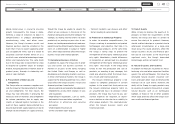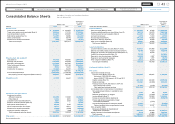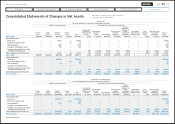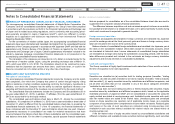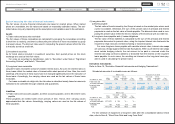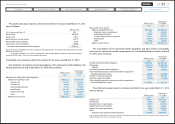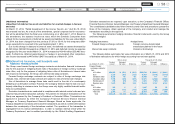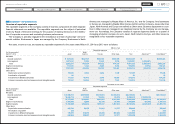Mazda 2014 Annual Report Download - page 52
Download and view the complete annual report
Please find page 52 of the 2014 Mazda annual report below. You can navigate through the pages in the report by either clicking on the pages listed below, or by using the keyword search tool below to find specific information within the annual report.
asset without any adjustments. For determining the method of attributing expected benefit
to periods, the Standard now allows to choose benefit formula basis, as well as straight-
line basis. Method for determination of discount rate has also been amended.
(2) Effective dates
Amendments relating to determination of retirement benefit obligations and current service
costs are effective from the beginning of years ending on or after March 31, 2015.
(3) Effect of application of the standard
As a result of the application, it is estimated that beginning balance of retained earnings
will increase by ¥2,874 million ($27,903 thousand) and operating income and income
before income taxes will increase by ¥648 million ($6,291 thousand) for the year ending
March 31, 2015.
4
FINANCIAL INSTRUMENTS
Qualitative information on financial instruments
Policies for using financial instruments
The Group finances cash mainly through bank loans and the issuance of bonds, in light of
planned capital investment. Temporary surplus funds are managed through investments in
low-risk assets. Short-term operating funds are financed mainly through bank loans and
commercial paper. Our policies on derivative instruments are to use them to hedge risks, as
discussed below, and not to conduct speculative transactions.
Details of financial instruments and the exposures to risk
Trade notes and accounts receivable, while mostly due within one year, are subject to cus-
tomers’ credit risks. Accounts receivable denominated in foreign currencies are subject to
the risk of fluctuations in foreign currency exchange rates; such risk is hedged, in principle,
by netting the foreign-currency-denominated accounts receivable against accounts pay-
able, and applying foreign exchange forward contracts on the resulting net position.
Short-term investments consist mainly of certificates of deposit and other highly-liquid
short-term investments. Investment securities consist mainly of stocks of our business
partner companies and are subject to the risk of market price fluctuations and other factors.
Long-term loans receivable are provided mainly to our business partner companies.
Trade notes and accounts payable, as well as other accounts payable, are due within
one year. Of these payables, those denominated in foreign currencies are subject to the risk
of fluctuations in foreign exchange rates. However, the balance of such payables denomi-
nated in major currencies is constantly less than that of the accounts receivable denomi-
nated in the same foreign currency. For minor currencies where this does not apply, such
payables are hedged, as necessary, through foreign exchange forward contracts, consid-
ering the transaction amounts and the degree of risk of foreign exchange rate fluctuation.
Loans payable, bonds payable, and finance lease obligations are mainly intended
for financing cash required for capital investment. The longest time to maturity of these
liabilities is 58 years and 4 months from March 31, 2014. Of these liabilities, those of the
variable-interest-rate type are subject to the risk of interest rate fluctuations; part of them is
hedged through derivative transactions (interest rate swaps).
Derivative instruments consist of foreign exchange forward contracts and interest rate
swaps. For details on derivative instruments, refer to “Derivatives and hedge accounting”
under Note 2, “Significant Accounting Policies”, and Note 15, “Derivative Financial
Instruments and Hedging Transactions”.
Policies and processes for managing the risk
Management of credit risks (i.e., risks associated to the default of counterparties)
The Group manages credit risks, in compliance with internal control rules and procedures.
The due dates and the balances of trade notes, accounts receivable, and loans receiv-
able from major counterparties are monitored and managed, in order to detect early and
mitigate the risk of doubtful receivables.
Short-term investments are limited mainly to time deposits and certificates of deposit of
banks approved by the Finance Officer. As such, the credit risks of these short-term invest-
ments are considered to be minimal.
Derivative transactions are executed only with banks with high credit ratings, in order to
mitigate counterparty risk.
For both short-term investments and derivatives, the credit risks of counterparty finan-
cial institutions are reviewed on a quarterly basis.
The amount of maximum risk as of March 31, 2014 is represented by the balance sheet
amount of financial assets exposed to credit risks.
Management of market risks (i.e., risks associated to fluctuations in foreign exchange
rates and interest rates)
The Company and some of its consolidated subsidiaries hedge the risk of foreign
exchange rate fluctuation on foreign-currency-denominated receivables and payables,
using foreign exchange forward contracts, on a monthly and individual currency basis.
Foreign exchange forward contracts are executed as necessary, up to six months ahead at
longest, on foreign-currency-denominated receivables and payables that are expected to
arise with certainty as a result of forecasted export and import transactions.
The Company and some of its consolidated subsidiaries use interest rate swaps in
order to reduce the risk of interest rate fluctuation on loans payable.
For details on management of derivative transactions, refer to Note 15, “Derivative
Financial Instruments and Hedging Transactions”.
50
Mazda Annual Report 2014
CONTENTS
Foundations Underpinning
Sustainable Growth
Financial Section
Review of Operations
Message from Management
Introduction
Brand Value Management



